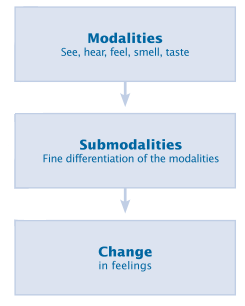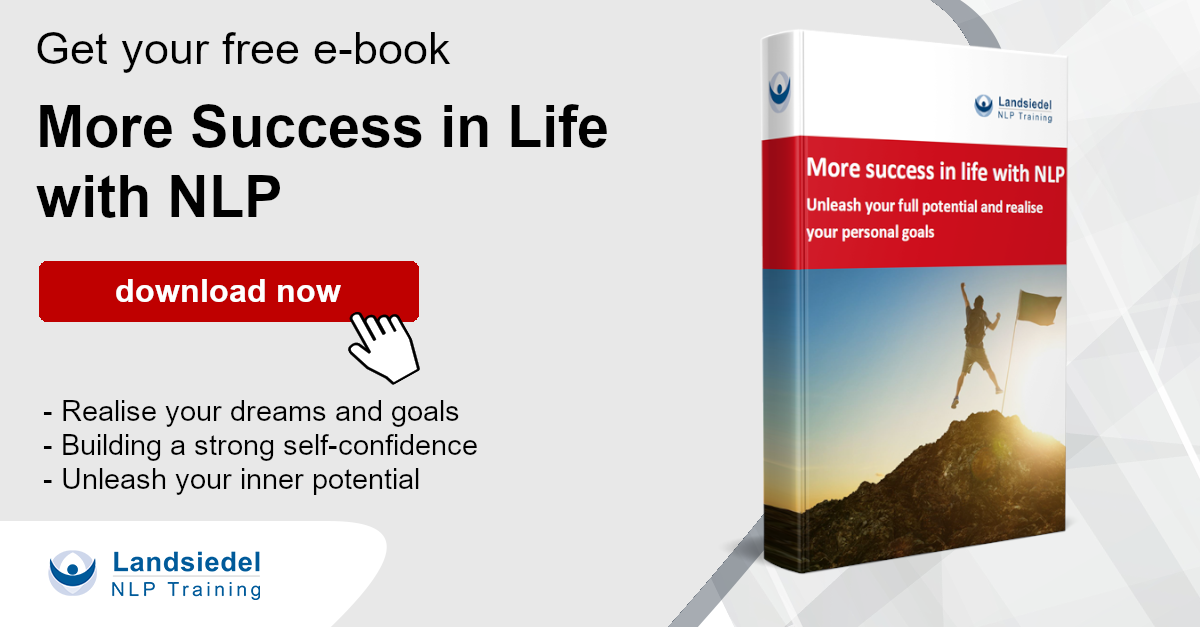Submodalities
Discover the programming language of subjective experience with this NLP technique. This high-caliber tool allows you to quickly affect emotional life and get rid of annoying behavioral habits or fears.
Introduction
 Here is an explanation of submodalities and why it is important to deal with them.
Here is an explanation of submodalities and why it is important to deal with them.
We receive information about the world through our five senses, which we have abbreviated to VAKOG. These senses are sometimes called modalities.
Submodalities are the next smaller building blocks of subjective experience. Within each modality we can distinguish different submodalities, e.g., in the visual range: light-dark, color-black and white, sharp-blurred, etc. In the auditory range: loud-low, low-high, clear-indistinct, etc. Every picture, noise or feeling can be described with the aid of numerous submodalities. So far, we have focused our attention on what someone represents in content, e.g., what he sees and what he hears. Now let's focus on what the inner picture, inner sound, or inner feeling is like.
The fascinating discovery in NLP is that the formal "difference" in the submodalities is often more powerful than the content of the experience. So that means that our body sensations and feelings depend more on the submodalities of the internal representation than on the content. Because of this unusual discovery, Bandler and others have developed effective and extremely fast intervention patterns.
Modalities = representation systems VAKOG | |
| visual | see |
| auditive | listen |
| kinesthetic | feel |
| olfactory | smell |
| gustatory | taste |
⇩
Submodalities = fine distinctions of the senses Sensual coding of language | ||
| visual | light-dark | near-far |
| auditive | loud-quiet | high-low |
| kinesthetic | warm-cold | solid-soft |
| olfactory | fragrant | stinking |
| gustatory | sweet-sour | fruity-harsh |
⇩
Meta-Feelings = the experience of evaluating feelings - emotional correspondence of the sensually packaged experience |
Destruction of Inner Images
Sometimes you will want to get rid of an existing negative vision. First ask yourself whether you have really learnt everything there is to learn from this negative vision. It can sometimes be a good idea to keep a negative picture, if it reminds you of certain issues which are best not forgotten – it can help prevent you from making the same mistake twice.
So save everything that is important and then start to destroy the image you want to get rid of. Imagine the picture as if it was on a mirror and take a hammer, strike hard and smash the picture. Caution! This is a mental exercise – the smashing only takes place in your mind. Imagine the picture breaking into a thousand pieces. You have destroyed it! You can repeat this step if you want. You might find it's really fun smashing this picture that's been plaguing you. Then mentally collect the pieces and let them be completely squashed by a steam roller so that there's nothing at all left of this picture or its effects. This exercise sounds harmless but is very effective.
Can you notice a difference? Are your feelings about this goal getting stronger? And now, as star director, add the finishing touches to these visions. Watch the scene from different angles. Change the speed, make it slower and then faster again. Remember which changes feel best for you. Work on this scene until you can hardly endure the strength of your own motivation and can't wait to make your goal a reality.
What you imagine is important, but what you do is also crucial. Big coloured pictures motivate most people more than small ones in black and white. These subtle differences within our senses are called submodalities in NLP. Find your favourite modalities and apply them to your dreams and goals.
Verbal indicators of submodalities
Submodalities can be displayed in language. Here are some examples:
- I have only vague ideas about my future.
- He has a bright future ahead of him.
- His past is in the dark.
- The future is cloudy.
- She is cold to me.
- He’s getting hot under the collar.
- She just gets under my skin.
Checklist of possible sense modalities
This section contains a collection of different submodalities in the different senses.
Visual submodalities

- Film/Stand-motion Picture: Is it a film or a stand-motion picture?
- Colour/Black and White: Is the image in colour or black and white?
- Right/Left/Centre: Where is the image located? right, left, centre?
- Up/Middle/Bottom: Is the image at the top, middle or bottom?
- Bright/Dampened/Dark: Is the image bright, muted, dark?
- Lifesize/Bigger/Little: If the image has life size, is it larger or smaller?
- Proximity: At what distance from you is the picture?
- Fast/Slow: Does the picture move fast, at a moderate speed or slowly?
- Specific Angle of View: Is a specific element constantly in focus?
- Own location: Are you part of the picture or are you watching the scene from a distance?
- Frame/Panorama: Does the picture have a frame, or is it a panorama shot?
More about the coaching tool: Social Panorama - 3-D/2-D: Is the image three- or two-dimensional?
- Special Colour: Is there a colour that impresses you the most?
- Own Point of View: Do you look at the picture from above, from below, from the side, etc.?
- Certain own Triggers: Are there any other stimuli that trigger strong feelings in you?
Auditive submodalities

- Self/Other: Do you say something to yourself, or do you hear something from others?
- Content: What exactly do you say or hear?
- The way it is said: How do you say or hear it?
- Volume: How loud is what being said?
- Sound Character: What is the sound character like?
- Tempo: How fast is it said?
- Source: Where do the lutes/sounds come from?
- Harmony/Cacophony: Are the sounds harmonic, or are there dissonances?
- Regular/Irregular: Are the sounds heard regularly or irregularly?
- Modulation: Is the voice modulated?
- Certain Words: Are certain words emphasised?
- Duration: How long are the sounds to be heard?
- Uniqueness: What is so unique about these lutes?
- Certain triggers: Are there other stimuli that trigger strong feelings in you?
Kinesthetic Submodalities

- Temperature Change: Has a temperature change taken place? Hot or cold?
- Surface Structure: Has there been a change in the surface structure? Rough or soft?
- Rigid/Flexible: Is it rigid or flexible?
- Vibration: Are vibrations noticeable?
- Print: Has the print increased or decreased?
- Print Source: Where was the starting point of the print?
- Tension/Relaxation: Has the tension or relaxation increased?
- Movement: Was there any movement? If so, in what direction and at what speed ?
- Breathing: Which breathing technique? Where did it start/end?
- Weight: Heavy or light ?
- Continuous/Interval: Are the feelings lasting or are they triggered at intervals?
- Size/Form Change: Has the size or shape changed?
- Direction: Are the feelings flowing into or out of the body?
- Certain Triggers: Are there other stimuli that trigger strong feelings in you?
Exercises & Techniques
Exercise
The mode of action of submodalities can be experienced only in exercises. Please do these exercises if you want to learn more about submodalities.-
Destroying images
Threatening inner visual images can be destroyed, thus losing their scary or frightening effect. Destroying Images. -
Destroying auditory representations
Everybody carries around inner voices that do not always say nice things. Using the techniques presented here, you can rid yourself of these inner voices in a fun way. Destroying auditory representations. -
The Chocolate Pattern
A pattern for something that you do not like to do but have to do with more motivation. The Chocolate Pattern. Changing a belief
A strategy for getting rid of limiting beliefs and adopt new beliefs. Changing a belief.Worst enemy
Using this technique, you can shrink your Worst Enemy in size so that he/she is no longer threatening.Swish pattern
The Swish pattern helps to remove annoying habits and build strong, positive motivation.
